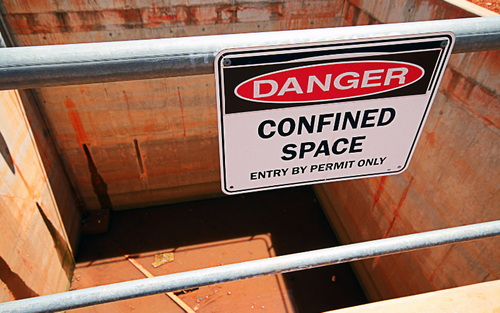Hierarchy of Controls for Confined Space
Confined spaces may be difficult and dangerous to work in, but that doesn’t mean that you can’t take steps to make these areas more comfortable or safer. An abundance of caution is always going to be a great tool, but sometimes the easiest and safest thing to do is get rid of hazards contained within the space completely. If that’s not possible, there are more steps to take in the form of the hierarchy of controls. Here is our take on the hierarchy of controls to consider implementing before working in a confined space, starting in order from highest priority of importance.
Hazard Elimination
Your first order of business should be to totally eliminate the hazard if possible. Physically removing or controlling the hazard will allow employees to do their work safely and exit once the job is done. The question to ask is what elements are present that cause danger for the workers? Is it an electrical hazard, danger of engulfment in a silo, or perhaps toxic gas from a process.
Bad air may be generated in any number of ways. In the case of confined spaces, this might look like mandating forced-air ventilation to remove or refresh an atmosphere that contains respiratory hazards.
Hazard Substitution
If you can’t remove the hazard completely, you might be able to change the nature of the hazard and make the space more comfortable. For example, if you can clear debris out of a space with a vacuum and extended hose, that eliminates the need to send anyone into the confined space to remove it. Another solution could be to replace toxic substances with less toxic or non-toxic ones to avoid creating hazardous atmospheres.
Engineering Controls
Isolating people from hazards with physical means to limit exposure is your next option. This might mean designing or redesigning a confined workspace so that a hazardous atmosphere can’t develop. This might mean installing a new automatic ventilation system, redesigning the entrance to be more accessible, or redesigning a confined space with a safer configuration.
Administrative Controls
When there’s nothing physical you can do, you can change how people work. Before anyone enters the confined space, establish an entry permit procedure to certify the safety aspects in advance. Then display it at the entrance of the space to show that it’s safe for employees to enter, in addition to detailing appropriate conditions for entry.
Safer work practices can also be achieved: consider establishing standardized safe entry procedures, rotating worker shifts, and general good housekeeping practices that will keep the confined space as decontaminated as possible.
Personal Protective Equipment
If you can’t remove or reduce the hazard through any of the above controls, then workers must use personal protective equipment (PPE) to stay safe. A qualified person on your worksite can determine what entrants will need to wear. For confined spaces, you’ll probably need respirators to protect against atmospheric hazards, possibly a personal air supply, gas monitors, and fall protection equipment, among other supplies you’ll need for your particular job and space. PPE should be in good working condition and inspected before each use.
PK Safety Confined Space Equipment
PPE is your last resort when it comes to protecting yourself and your workers from confined space hazards. When you need to invest in that equipment, though, PK Safety is your workplace safety partner. We’ve spent over 70 years in the business of making sure workers are safe and well-equipped, and we carry the best brands and have the expert advice to keep you as safe as possible. Contact a safety expert online or call 800.829.9580.
Recent Posts
-
Customizing Gas Detectors: Tailoring Solutions to Fit Your Unique Requirements
In today’s diverse industrial landscape, a one-size-fits-all approach to safety simply doesn’t cu …Jul 3rd 2024 -
10 Ways to Prevent Wildfires
You can prevent wildfires by extinguishing flames before you leave the worksite. Avoid practicing …Jul 1st 2024 -
ANSI/ISEA 138 Safety Gloves: Ensuring Hand Protection
The human hand is an anatomical masterpiece and arguably the greatest tool attached to our bodies …Jun 25th 2024





